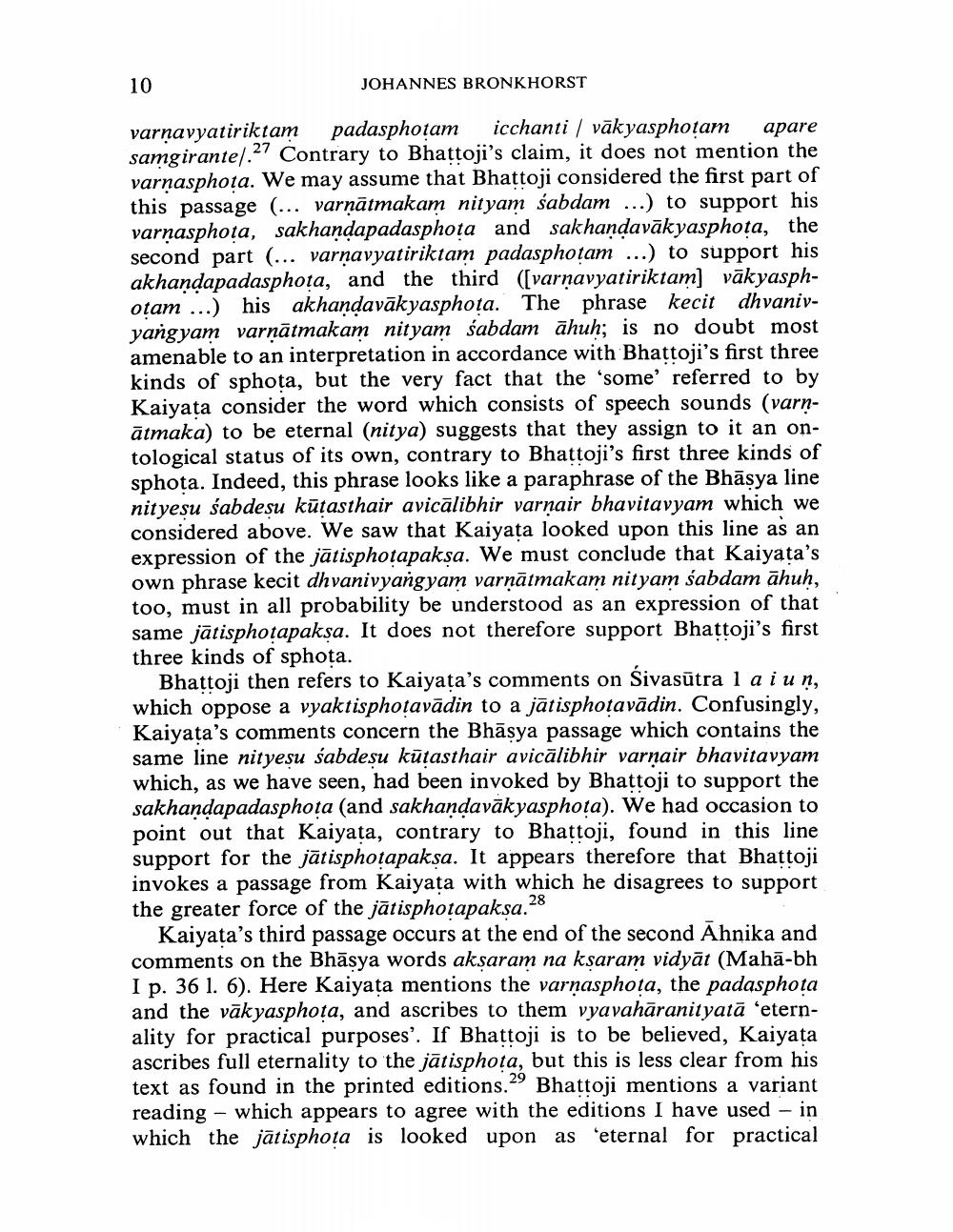Book Title: Bhattoji Diksita On Sphota Author(s): Johannes Bronkhorst Publisher: Johannes Bronkhorst View full book textPage 8
________________ 10 JOHANNES BRONKHORST varnavyatiriktam padasphotam icchanti vākyasphoṭam apare samgirante/.27 Contrary to Bhattoji's claim, it does not mention the varnasphota. We may assume that Bhattoji considered the first part of this passage (... varṇātmakam nityam sabdam ...) to support his varnasphota, sakhandapadasphota and sakhandavākyasphota, the second part (... varnavyatiriktam padasphotam ...) to support his akhandapadasphota, and the third ([varnavyatiriktam] vākyasphotam ...) his akhandavākyasphota. The phrase kecit dhvanivyangyam varṇātmakam nityam sabdam ahuh; is no doubt most amenable to an interpretation in accordance with Bhattoji's first three kinds of sphota, but the very fact that the 'some' referred to by Kaiyata consider the word which consists of speech sounds (varnatmaka) to be eternal (nitya) suggests that they assign to it an ontological status of its own, contrary to Bhattoji's first three kinds of sphota. Indeed, this phrase looks like a paraphrase of the Bhāṣya line nityesu śabdesu kūṭasthair avicālibhir varṇair bhavitavyam which we considered above. We saw that Kaiyaṭa looked upon this line as an expression of the jatisphotapakṣa. We must conclude that Kaiyata's own phrase kecit dhvanivyangyam varṇātmakam nityam sabdam āhuḥ, too, must in all probability be understood as an expression of that same jätisphotapakṣa. It does not therefore support Bhattoji's first three kinds of sphota. Bhattoji then refers to Kaiyata's comments on Śivasūtra la i un, which oppose a vyaktisphoṭavādin to a jatisphoṭavādin. Confusingly, Kaiyata's comments concern the Bhāṣya passage which contains the same line nityeṣu sabdeṣu kūṭasthair avicālibhir varnair bhavitavyam which, as we have seen, had been invoked by Bhattoji to support the sakhaṇḍapadasphota (and sakhandavākyasphota). We had occasion to point out that Kaiyata, contrary to Bhattoji, found in this line support for the jätisphotapakṣa. It appears therefore that Bhattoji invokes a passage from Kaiyata with which he disagrees to support the greater force of the jatisphotapaksa.28 Kaiyata's third passage occurs at the end of the second Āhnika and comments on the Bhāṣya words akṣaram na kṣaram vidyāt (Mahā-bh I p. 36 1. 6). Here Kaiyața mentions the varṇasphota, the padasphota and the vakyasphota, and ascribes to them vyavahāranityatā ‘eternality for practical purposes'. If Bhattoji is to be believed, Kaiyaṭa ascribes full eternality to the jätisphota, but this is less clear from his text as found in the printed editions.29 Bhattoji mentions a variant reading which appears to agree with the editions I have used in which the jätisphota is looked upon as 'eternal for practical -Page Navigation
1 ... 6 7 8 9 10 11 12 13 14 15 16 17 18 19 20 21 22 23 24 25 26 27 28 29 30 31 32 33 34 35 36 37 38 39
